 Last Updated February 9, 2025
Last Updated February 9, 2025
The most common Vitamix shopper’s question is some variant of, “I want to make smoothies, soups, and frozen desserts. Which Vitamix blender is best for me?” The answer is that all Vitamix machines work great for those tasks; which one is best depends on the volumes you want to blend and whether you want to pay for extra features.
If you don’t want to go through the nitty-gritty, here are my quick Vitamix recommendations:
Which is the best Vitamix model?
Best Value
- E310 (short/narrow container for small to medium amounts)
- Recon 5200 (tall/narrow container for small to large amounts)
- Recon E320 (short/wide container for medium to large amounts)
Money Is No Object
- Ascent X5 (latest and greatest)
The February 2025 shopping landscape
Most Vitamix models are on sale through Feb 22nd for the President’s Day Sale. Here is the sale.
Vitamix recently released a new set of Ascent models. Full details are in my Vitamix Ascent X Series Review.
The Food Processor Attachment gives more reason to consider Ascent and Venturist models, since it is not compatible with classic models. If you don’t care about the premium finish of the A3500, consider saving big on the Reconditioned Venturist.
If you are looking for the lowest possible price, I recommend choosing between the Recon 5200, the E310, and the Recon E320. The most significant difference between these models is the container they come with, so use the following Venn diagram to pick the optimal container for you. There are trade-offs between the three container options. To put it briefly, “short, narrow, or large capacity: pick 2”: 
Note to visitors from outside the United States: The model availability described on this page is for the USA (and APO/FPO addresses). If you are shopping from Canada, check out my page about Canadian Vitamix models.
For most people, I recommend choosing from the following four categories: Certified Reconditioned models, Explorian, Premium Classic, and Ascent.
Reconditioned
 If you are looking for the lowest possible price on Vitamix, reconditioned is for you. Some people are hesitant to buy reconditioned, and that is a valid concern with some companies, but Vitamix’s reconditioned units are guaranteed to be top quality. The only reasons I would avoid reconditioned Vitamix are if it is for a gift for someone who won’t understand, or if you want some of the features not available on reconditioned machines.
If you are looking for the lowest possible price on Vitamix, reconditioned is for you. Some people are hesitant to buy reconditioned, and that is a valid concern with some companies, but Vitamix’s reconditioned units are guaranteed to be top quality. The only reasons I would avoid reconditioned Vitamix are if it is for a gift for someone who won’t understand, or if you want some of the features not available on reconditioned machines.
Explorian
 If you prefer a slightly smaller container, I highly recommend the new E310, which comes with a short and narrow 48-oz container (full review). The Explorian E320 is functionally identical to the E310, but it comes with a wide container. That makes it nearly identical to the 5300. (The E320 replaces the 5300 in the model lineup, and it is mostly the same, with a few changes: it does not have the on-off switch on the side, and it does not light up when on. I don’t think these differences matter much, but there they are for anyone wondering about E320 vs. 5300.)
If you prefer a slightly smaller container, I highly recommend the new E310, which comes with a short and narrow 48-oz container (full review). The Explorian E320 is functionally identical to the E310, but it comes with a wide container. That makes it nearly identical to the 5300. (The E320 replaces the 5300 in the model lineup, and it is mostly the same, with a few changes: it does not have the on-off switch on the side, and it does not light up when on. I don’t think these differences matter much, but there they are for anyone wondering about E320 vs. 5300.)
There is now also an Explorian E520, which comes with the wide 64-oz container and adds 3 preset blending modes. With the hidden discount that gets activated after clicking a Vitamix link on this site and then adding the Recon E520 to your shopping cart, it is an excellent deal.
Premium Classic and Propel
If you want the most premium machine, but don’t want the new technology of Ascent, then the Professional Series 750 is for you. I think the Ascent machines are quite nice, but you might not like the look of their digital display, or you might want to be able to use older containers (without NFC chips).
In 2023 Vitamix released a new Series, which they are calling the Propel. Similar to the Pro 750, these machines have preset modes and a secondary on-off switch. The Propel machines also have the subtly updated styling that was released with the Explorian series: Propel 510 and Propel 750.
Ascent (Smart System Blenders)
If you want to buy into the future of Vitamix, the Ascent Series is the way to go. It’s priced in the same range as new Legacy models, but it comes with various upgrades (among them: longer warranty, timer display, can use small cups without bulky adapter, and a wireless connection to smartphone app).

 Within the Ascent Series, the A2300 is the lowest-priced model and it has everything you need. (If you’re buying reconditioned, the A2500 is the lowest-priced model, and it has all the features of the A2300, including full variable speed control, and it adds 3 preset program modes.) If you feel like upgrading, I recommend going all the way up to the A3500, because it has premium finish options. (I’m not saying that the intermediate Ascent models are a bad choice, they just wouldn’t be my choice.) See my Ascent review page for more details.
Within the Ascent Series, the A2300 is the lowest-priced model and it has everything you need. (If you’re buying reconditioned, the A2500 is the lowest-priced model, and it has all the features of the A2300, including full variable speed control, and it adds 3 preset program modes.) If you feel like upgrading, I recommend going all the way up to the A3500, because it has premium finish options. (I’m not saying that the intermediate Ascent models are a bad choice, they just wouldn’t be my choice.) See my Ascent review page for more details.
If you’ve been putting off getting a Vitamix because you’re saving up, you can get one right away with a payment plan. If you make on-time payments, there are zero financing fees.
You can leave a comment below or contact me if you are still having trouble deciding which one to get.
Comparison of pre-Ascent models follows
If you want to quickly see the relation between all of the different Vitamix models, you can jump ahead to my comparison chart.
I made an interactive tool to help explore the different features. Try playing with it to get a sense of which you are interested in. You can click any model to go to its Vitamix.com page, or you can read more about the different models below.
+ Show model selection tool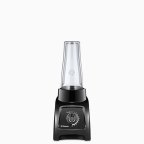 Recon S30
Recon S30  Recon 2-Speed
Recon 2-Speed  Recon 5200
Recon 5200  Recon 5300
Recon 5300  Recon Pro 500
Recon Pro 500 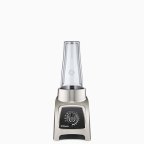 Recon S55
Recon S55  S30
S30  2-Speed
2-Speed 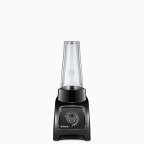 S50
S50  Recon 7500
Recon 7500  5200
5200  S55
S55 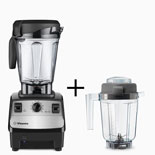 Recon 5300 + 32oz
Recon 5300 + 32oz  Recon Pro 750
Recon Pro 750  7500
7500  Pro 500
Pro 500  Recon 7500 + 32oz
Recon 7500 + 32oz  Pro 750
Pro 750 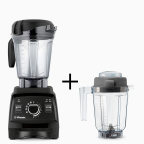 Recon Pro750+32oz
Recon Pro750+32oz  7500 + 32oz
7500 + 32oz  Pro 750 + 32oz
Pro 750 + 32oz  780
780 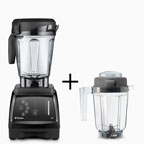 780 + 32oz
780 + 32oz(If you want the 32-oz container, you have to add it to your cart separately: 32-oz container link)
If you’re overwhelmed by the choices and just want to know my preference, I’ve used all of the different types of Vitamix blenders, and before I started using Ascent, the one I used on a daily basis was the 7500, with an extra 32-oz container for blending smaller amounts. (For the best deal, check out certified reconditioned.) All of the models are excellent, and I don’t think there is a wrong choice. (Plus, if you change your mind in the first 30 days, you can get a full refund, including free shipping both ways.)
Summary of Differences
These are the five key decisions to make when deciding which Vitamix to buy:
The following comparison chart shows the relations between the different machines in the S-Series, C-Series, and G-Series. The machines within most boxes of the chart are identical, but they come with different accessories and cookbooks (the exceptions are the S50 and S55, where the S55 has 2 more presets than the S50, and the Pro 750 and Vitamix 780, where the 780 has a flat touchpanel control). Generally the differences in accessories/cookbooks are pretty marginal, so I’d recommend going for the lowest price model within the box.

(“+” indicates there are also more expensive options in addition to the price listed in the chart. The following machines are not shown because they do not fit in with the rest: the Vitamix Turboblend Two Speed and Three Speed lack variable speed control, and the Vitamix 5300 and 6500 are a hybrid of the 6300 and 7500—i.e. they have a 7500 container on a 6300 base, without or with presets.)
Personal Blender? (S-Series vs. C-Series and G-Series)
(Vitamix S30 and S55 vs. 5200, 7500, et al.)
 In 2014 Vitamix released the Vitamix S30. It is smaller than the other Vitamix models, and also comes with a combination blending container/to-go smoothie cup. The Vitamix S50 and Vitamix S55 came out in 2015, and they are the same as the S30 but add preset modes. Since these models are significantly different from all the other models, I put up a detailed Vitamix S30 and S-Series review. If you are considering a smaller blender, or like the idea of blending in a to-go smoothie cup, you should check them out. Not surprisingly, the S-Series’ smaller size means that their maximum capacity is lower the other models (40 oz vs 64 oz).
In 2014 Vitamix released the Vitamix S30. It is smaller than the other Vitamix models, and also comes with a combination blending container/to-go smoothie cup. The Vitamix S50 and Vitamix S55 came out in 2015, and they are the same as the S30 but add preset modes. Since these models are significantly different from all the other models, I put up a detailed Vitamix S30 and S-Series review. If you are considering a smaller blender, or like the idea of blending in a to-go smoothie cup, you should check them out. Not surprisingly, the S-Series’ smaller size means that their maximum capacity is lower the other models (40 oz vs 64 oz).
Variable Speed?
(Vitamix Two Speed vs. 5200 and Vitamix 6000 vs. 6300)
 The variable speed control found on all Vitamix machines except for the Two Speed and 6000 is useful for when you don’t want to fully liquefy your blend. Examples are pesto, salsa, or chopping vegetables. If you don’t have variable speed, you can get away with quickly pulsing, but you won’t have quite as much control. The variable speed also makes the “bubble removal trick” more effective, although pulsing on low speed also works.
The variable speed control found on all Vitamix machines except for the Two Speed and 6000 is useful for when you don’t want to fully liquefy your blend. Examples are pesto, salsa, or chopping vegetables. If you don’t have variable speed, you can get away with quickly pulsing, but you won’t have quite as much control. The variable speed also makes the “bubble removal trick” more effective, although pulsing on low speed also works.
Preset Programs?
(Vitamix Two Speed vs. 6000, Vitamix 5200 vs. 6300, Vitamix Professional Series 200 vs. Professional Series 500, Vitamix S30 vs. S55, and Vitamix Professional Series 300 vs. Professional Series 750)
 The preset programs on the 6000, 6300/Pro 500, S55, and Pro 750 allow you to select a program, turn it on, and then the machine will automatically ramp up the speed and then shut off after a certain amount of time. There are a number of reasons that people appreciate this function:
The preset programs on the 6000, 6300/Pro 500, S55, and Pro 750 allow you to select a program, turn it on, and then the machine will automatically ramp up the speed and then shut off after a certain amount of time. There are a number of reasons that people appreciate this function:
• You can start the machine and “walk away” to do something else.
• If you strictly follow recipes the presets can yield more consistent results.
• Presets can give new users more confidence with the machine.
However, the presets do not work perfectly every time. Sometimes ingredients require tamping to start circulating past the blades, so you can’t always “walk away.” Also, the preset time might not be the optimum blending time if you modify a recipe. You may find that your smoothie is not fully blended after the smoothie program runs, so you have to run it again. A commercial coffee or smoothie shop makes the same recipes over and over, so in that setting presets are extremely useful. If you constantly make new combinations and of differing amounts, as many home users do, the settings may be less useful. It’s not too hard to tell when something is sufficiently blended, and after a few trials anyone should be able to figure it out. For these reasons, I personally would not pay extra for the preset settings. However, I know many people who have the presets love them. One thing to remember is that the machines with presets still have the variable speed knob for full manual control. If you don’t mind the added cost of presets, you can always switch back and forth to manual control.
C-Series vs. G-Series (Next Generation)?
(Vitamix 5200 vs. 7500, and Vitamix Professional Series 500 vs. Professional Series 750)
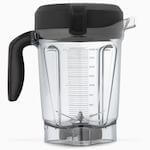 Vitamix released the “Next Generation,” aka “G-Series,” models in 2012. Both the base and the pitcher have an updated design. The base has slightly better sound muffling and also has better airflow which means that it can work harder before it overheats. To go with the better-cooled motor, the updated pitcher has a 4-inch blade instead of the Standard/Classic “C-Series” 3-inch blade. The 4-inch blade is in a shorter and wider container that has the same capacity as the 64-oz C-Series container.
Vitamix released the “Next Generation,” aka “G-Series,” models in 2012. Both the base and the pitcher have an updated design. The base has slightly better sound muffling and also has better airflow which means that it can work harder before it overheats. To go with the better-cooled motor, the updated pitcher has a 4-inch blade instead of the Standard/Classic “C-Series” 3-inch blade. The 4-inch blade is in a shorter and wider container that has the same capacity as the 64-oz C-Series container.
Advantages of the wider design:
• less need for the tamper (ingredients fall into the blades more easily)
• better chopping capability (you can course-chop more ingredients at a time)
• easier to scrape thick mixtures out
Advantage of shorter design:
• easier storage (at 17.5” tall, the container with lid on the base fits under standard kitchen cabinets)
Advantages of the 4-inch blade:
• faster processing time
• under some circumstances, marginally smoother blends
The one disadvantage of the new container is that for small volumes of under ~2 cups it does not work quite as well as the C-Series narrow container. The G-Series wider design causes two things to happen. First, there is more splashing up onto the inside of the lid and upper walls of the container, which means you lose a small amount of your blend unless you carefully scrape off the lid and walls. Second, you need slightly more volume to cover the blades and get good circulation going. The minimum volume to blend depends on what you are blending, and also on how much effort you are willing to spend pushing ingredients back into the blades. For example, for best results, the narrow containers can make nut butter easily by starting with 3 cups of nuts, whereas the wider Next Generation containers do best with 4 cups of nuts. For easier, more liquidy, blends, you can go below 1 cup in either container, but Next Generation containers will splash around more.
This disadvantage is a non-issue if most of your blends are over 2 cups, or if you are willing to spend a bit more to buy an additional narrow container, which will give you the best of both worlds. I like the 32-oz container for this purpose, although the 48-oz container has the same narrow bottom so it works just as well. The 48-oz container is just a bit bulkier on the outside because it sits outside the centering posts instead of inside of them, and its top is wider as well.
(The narrow C-Series Vitamix containers are compatible with G-Series models, but the G-Series containers are not recommended for use on C-Series models. The longer G-Series blades increase the load, and Vitamix does not recommend the C-Series cooling system for those increased loads.)
Reconditioned?
 Buying reconditioned is a great way to save money. For more details on deciding about buying reconditioned, see my refurbished Vitamix page.
Buying reconditioned is a great way to save money. For more details on deciding about buying reconditioned, see my refurbished Vitamix page.
Continue on for more details of each model type…
The array of different Vitamix blenders is a bit confusing, but it turns out that there is a lot of redundancy between the different models. I am only discussing models made for consumer/home use. Their commercial blenders are not ideal for home use because they are generally more expensive and have shorter warranties (3 years vs 7 years for home use; they are warrantied for constant use—think of how many times per day a blender at Jamba Juice runs compared to at your home).
The Vitamix website currently lists over 30 different home models, but they are all variants of three main designs: “personal” (S-Series), “standard/classic” (C-Series), and “next generation” (G-Series). For each of these main designs there are a few different options, to make a total of 8 different machine types. The rest of the models have identical bases, but come with different containers and/or accessories.
S-Series Motors
If the smaller size, dishwasher safe container, and “to-go” blending container appeal to you, please read the full details at my Vitamix S30, S50, and S55 review. For quick reference, the size of the base is 8.3″ deep x 5.9″ wide x 7.7″ tall. With the 20-oz to-go container the total height is 14.55″. The height is 15.66″ with the 40-oz container. These models have lower power, but they are still capable of making all of the usual Vitamix creations, just in smaller quantities.
C-Series Motors (Standard/Classic)
There are three types of bases of the standard variety. The differences are in the controls. The dimensions of the base of these machines are 8.75″ deep x 7.25″ wide x 8.25″ tall. There are three different container size options: 32 oz, 48 oz, and 64 oz, which result in height of base plus container/lid of 16.9″, 17.4″, and 20.5″ respectively.
Standard, no-variable speed (Vitamix TurboBlend Two Speed and Three Speed)
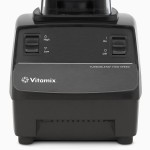 TurboBlend Two Speed (
TurboBlend Two Speed ($399$349); reconditioned for $299. This machine comes with a 5-year warranty and lacks the variable speed knob. Variable speed is useful for cases where you want to have finer control over the texture (i.e. if you don’t want a totally smooth purée). However, you can accomplish some non-liquefying chopping tasks by quickly pulsing the machine. While this is the most affordable new machine, I’d highly recommend looking at the reconditioned 5200, which has the same warranty and adds variable speed for $70 less.
In May 2016 Vitamix came out with a new no-variable speed machine, the TurboBlend Three Speed($499). It is exactly what it sounds like: it has three speed settings: low, medium, and high. It also has a pulse switch, which does the same thing as switching the start-stop button on and off. The pricing on this model is a bit strange, since for $50 less you can get a machine with fully variable speed. Plus, the TurboBlend 3-Speed comes with a 5-year warranty, instead of the 7 years on machines like the 5200.
Standard variable speed (Vitamix 5200 et al.)
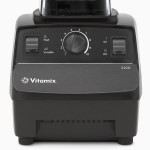 Until recently this was Vitamix’s bread and butter, and they have a lot of models to show for it: 5200 ($449), TurboBlend VS (retired), CIA Pro (retired), Pro 200 ($499), Creations II ($449), and Creations GC (retired); reconditioned for $329. These machines are essentially identical. Some are available with a shorter 48-oz container instead of the 64-oz container. The smaller container is nice because it’s more compact (and fits under standard kitchen cabinets), but of course its capacity is lower. The aesthetics of the switches and dial are slightly different between the different models. The Creations models come with a 5-year warranty, while the rest are 7 years. The 5200 comes with their “whole foods cookbook,” the TurboBlend VS comes with a vegetarian/vegan/raw cookbook and a nutmilk straining bag, the Pro models come with a cookbook with restaurant-oriented recipes (the CIA one—that’s Culinary Institute of America—comes with an additional recipe book). Note that if you buy reconditioned, you cannot choose which of the Standard models you are getting; Vitamix will choose for you based on availability, but remember that functionally they are identical.
Until recently this was Vitamix’s bread and butter, and they have a lot of models to show for it: 5200 ($449), TurboBlend VS (retired), CIA Pro (retired), Pro 200 ($499), Creations II ($449), and Creations GC (retired); reconditioned for $329. These machines are essentially identical. Some are available with a shorter 48-oz container instead of the 64-oz container. The smaller container is nice because it’s more compact (and fits under standard kitchen cabinets), but of course its capacity is lower. The aesthetics of the switches and dial are slightly different between the different models. The Creations models come with a 5-year warranty, while the rest are 7 years. The 5200 comes with their “whole foods cookbook,” the TurboBlend VS comes with a vegetarian/vegan/raw cookbook and a nutmilk straining bag, the Pro models come with a cookbook with restaurant-oriented recipes (the CIA one—that’s Culinary Institute of America—comes with an additional recipe book). Note that if you buy reconditioned, you cannot choose which of the Standard models you are getting; Vitamix will choose for you based on availability, but remember that functionally they are identical.
Sometimes these models are listed with their color-specific SKU. All of the following models are identical to the 5200, they just come with different colors and names: Vitamix 1709, 1363, 1364, 1365, 1709, 1723, 1732. They also sometimes go by VM0103. Vitamix 1978 is also the same, but comes with a 48-oz container.
Standard variable speed + presets (Vitamix 6300 and Professional Series 500)
 Pro 500 ($559) and 6300 (retired); reconditioned for $379. These are the same model; the only difference is that the 6300 comes with the “Savor” cookbook, which has a broader range of recipes than the Pro 500’s “Create” cookbook, which focuses more on restaurant-style recipes that tend to be richer.) They have 3 preset programs that run the blender for a certain amount of time and speed for smoothies, frozen desserts, and hot soups. Their switches are slightly different from the non-preset models. The non-preset models have an on-off switch, a variable speed knob, and a high-variable speed switch. The preset ones have moved the highest speed setting onto the knob and replaced the high-variable speed switch with a pulse switch. This is really a minor aesthetic difference, since you can achieve pulsing on the non-preset models by quickly flicking the on-off switch on and off.
Pro 500 ($559) and 6300 (retired); reconditioned for $379. These are the same model; the only difference is that the 6300 comes with the “Savor” cookbook, which has a broader range of recipes than the Pro 500’s “Create” cookbook, which focuses more on restaurant-style recipes that tend to be richer.) They have 3 preset programs that run the blender for a certain amount of time and speed for smoothies, frozen desserts, and hot soups. Their switches are slightly different from the non-preset models. The non-preset models have an on-off switch, a variable speed knob, and a high-variable speed switch. The preset ones have moved the highest speed setting onto the knob and replaced the high-variable speed switch with a pulse switch. This is really a minor aesthetic difference, since you can achieve pulsing on the non-preset models by quickly flicking the on-off switch on and off.
Some people love the presets because you can set it and walk away (assuming the mixture is circulating and you don’t need the tamper), and because they get more consistent results. However, the more consistent results will only hold if you always add the same quantities and types of items to the blender. For example, if you’re making a small smoothie, you can blend it for less time than if you were making a large one. One other thing is that you can set the non-preset machines and walk away—you just have to come back to stop them. I often use the blending time to rinse off the knife and cutting board that I used. You’re not likely to forget that the Vitamix is running because it’s loud enough to hear throughout the house. The variable speed knob goes to the same high speed as the previous models on high, but it’s lowest setting is a bit faster than on the 5200 et al., so you lose a tiny bit of fine control. Whether the presets are worth it is a personal question—I wouldn’t pay extra for them, but some people love them.
Standard no variable speed + presets (Vitamix 6000)
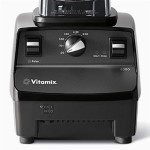 6000 (retired). Released October 2013, this is more of a mash-up of existing machines than a truly new one. It’s a sort of blend between the Two Speed, and the 6300. It does not have variable speed control, but it has six preset timed blending settings. These settings will automatically ramp up the speed, and then turn it off after a specified time of 20 sec, 30 sec, 1 min, 1.5 min, 4.5 min, or 6.5 min. Like the 6300, the pulse control is spring-loaded so that it only stays on as long as you hold it down, and it blends at a medium-low speed.
6000 (retired). Released October 2013, this is more of a mash-up of existing machines than a truly new one. It’s a sort of blend between the Two Speed, and the 6300. It does not have variable speed control, but it has six preset timed blending settings. These settings will automatically ramp up the speed, and then turn it off after a specified time of 20 sec, 30 sec, 1 min, 1.5 min, 4.5 min, or 6.5 min. Like the 6300, the pulse control is spring-loaded so that it only stays on as long as you hold it down, and it blends at a medium-low speed.
G-Series Motors (Next Generation)
In 2012 Vitamix released a new generation G-Series base with improved airflow that makes it run cooler and quieter than the classic C-Series one. With the improved cooling, the G-Series base can use a new pitcher design that is wider and has longer blades. This design makes the tamper less necessary, and makes it easier to get thick mixtures out. The longer blades also process food faster and work better for chopping. The G-Series machines are compatible with the C-Series containers, so if you want to use the dry blade you can use the same classic dry container. Dimensions are 9.4″ deep x 7.7″ wide x 17.5″ tall (with new-style 64-oz container in place). For more details of sizes, check out the PDF footprints I made for my Vitamix S30 review.
Next generation motor (Vitamix 7500, Professional Series 300, and Creations Elite)
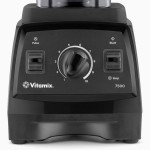 7500 ($529), Creations Elite ($557.50), and Pro 300 ($559); reconditioned for $439. These are all the same machine, so don’t worry about the note on the Reconditioned Next Gen page that says that the label may reflect any of these models. The only difference is the name printed on it. One point of confusion is that the Creations Elite is sold new with a smaller container, but if you happen to get sent a Creations Elite as a Reconditioned Next Gen, it will come with the same low profile 64-oz container that the 7500 comes with.
7500 ($529), Creations Elite ($557.50), and Pro 300 ($559); reconditioned for $439. These are all the same machine, so don’t worry about the note on the Reconditioned Next Gen page that says that the label may reflect any of these models. The only difference is the name printed on it. One point of confusion is that the Creations Elite is sold new with a smaller container, but if you happen to get sent a Creations Elite as a Reconditioned Next Gen, it will come with the same low profile 64-oz container that the 7500 comes with.
Next generation motor + presets (Vitamix Professional Series 750 and Vitamix 780)
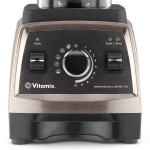
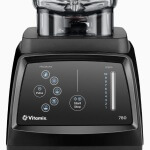 Pro 750 ($599–$649), 780 ($719); available reconditioned: 750 for
Pro 750 ($599–$649), 780 ($719); available reconditioned: 750 for $519–$569$499, and 780 for $519$399. These models have 5 presets: smoothies, frozen desserts, purées, hot soups, and self-washing. If you want to see more details of exactly what the presets do, check out my page about demystifying Vitamix presets. The 780 is identical, except that it has a touchpanel control interface. See my Vitamix 780 review for more details.
Vitamix Heritage 750 vs. Original 750?
In late 2015, Vitamix released a new version of the Pro 750: the Heritage line. The Vitamix Heritage 750 is functionally equivalent to the original Pro 750, but it has two differences on the exterior of the base. The upper shell (see diagram below) is now metal on the Heritage models. The Vitamix website doesn’t put Heritage in the model title, but it’s there in the description.
 The original 750 came in a brushed stainless finish option, but the upper shell was plastic with a thin metallic coat that could be scratched or scuffed. (When I tested the original 750 for a couple of months, I did not see any problems, but I have heard that some people have noticed scratches/scuffs.) The solid metal of the new Heritage models is more durable. Also, the metal shell muffles the the motor a bit more than the plastic, making the Heritage models a bit quieter.
The original 750 came in a brushed stainless finish option, but the upper shell was plastic with a thin metallic coat that could be scratched or scuffed. (When I tested the original 750 for a couple of months, I did not see any problems, but I have heard that some people have noticed scratches/scuffs.) The solid metal of the new Heritage models is more durable. Also, the metal shell muffles the the motor a bit more than the plastic, making the Heritage models a bit quieter.
 The other minor difference is that the Heritage models’ front panel has fewer backlights: Heritage models light up the indicators above the pulse and start-stop switches, whereas the original Pro 750 has backlights around the central knob as well.
The other minor difference is that the Heritage models’ front panel has fewer backlights: Heritage models light up the indicators above the pulse and start-stop switches, whereas the original Pro 750 has backlights around the central knob as well.
The Heritage metal is available in brushed stainless and copper finishes. (Currently on Vitamix.com, the Heritage options are listed on the main Pro 750 page, and the old brushed stainless finish is discontinued.)
I believe it is called Heritage because it is a throwback to the original Vitamix models that had all-metal bases. The plastic that Vitamix has been using for their bases for the past 25 years is extremely durable, so this change won’t affect functional longevity. That said, the elegant finish of the Heritage models will now likely stay unblemished for longer. It’s also nice that Vitamix did not increase the price for this upgrade.
The Vitamix 5300 and 6500
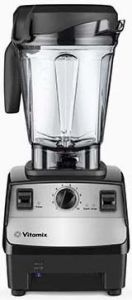 5300 ($529) and 6500 ($599); reconditioned for $360. Vitamix does not currently sell the new models online, only the reconditioned one. These are “new” models for 2015, although they are actually just slightly unexpected mash-ups of previous models. They are a hybrid between a 6300 and a 7500. They use the wide Next Gen (G-Series) container but they have a Classic (C-Series) base. The 5300 has variable speed and a pulse control switch, and has no presets. Meanwhile, the 6500 has the same three presets as the 6300. (Further evidence of equivalence between the 5300/6500 and C-Series models is on the Reconditioned C-Series 6300/Pro 500 page: it says its base may be a 6500.)
5300 ($529) and 6500 ($599); reconditioned for $360. Vitamix does not currently sell the new models online, only the reconditioned one. These are “new” models for 2015, although they are actually just slightly unexpected mash-ups of previous models. They are a hybrid between a 6300 and a 7500. They use the wide Next Gen (G-Series) container but they have a Classic (C-Series) base. The 5300 has variable speed and a pulse control switch, and has no presets. Meanwhile, the 6500 has the same three presets as the 6300. (Further evidence of equivalence between the 5300/6500 and C-Series models is on the Reconditioned C-Series 6300/Pro 500 page: it says its base may be a 6500.)
The reconditioned 5300 is the most affordable option for a machine with the short/wide container.
The strange thing about these models is that previously Vitamix stated that Next Gen containers should not be used on Classic bases because they do not have the updated airflow design that cools the motor more effectively.
I strongly suspect that the 5300 has the same microprocessor speed control as the 7500, Pro 750, and 6300, just without the presets. (You can read about the speed control of the different machines on my Vitamix RPM measurement page.) The microprocessor speed control should help protect the motor when using the wide container at high loads and very low speeds, but at maximum speed it shouldn’t make a difference. The marketing copy for the 5300 says that it comes “with a faster, yet quieter, motor,” but I am skeptical of those claims [Update: interestingly, Vitamix removed that phrase].
The 5300 and 6500 are a bit louder than the G-Series bases, which have sound-dampening technology not present in the C-Series bases. At the same price point, I would prefer the 7500.
Satisfaction Guarantee
Vitamix has a 30-day satisfaction guarantee, so if you have second thoughts you can return a machine within the first 30 days for a full refund and they even pay return shipping.
Warranty
If your machine has any problems during the warranty period of 5 or 7 years, Vitamix will repair or replace it, and they cover shipping costs both ways. For more details about warranties, check out my Vitamix Warranty page.
Reconditioned Vitamix
 I know I already mentioned reconditioned machines, but I want to restate what a great deal I think they are. These factory-refurbished machines offer the best prices you’ll find on Vitamix: 5200 for $329, Pro 500 for $379, and 7500 for $439. For more details, see my refurbished Vitamix page.
I know I already mentioned reconditioned machines, but I want to restate what a great deal I think they are. These factory-refurbished machines offer the best prices you’ll find on Vitamix: 5200 for $329, Pro 500 for $379, and 7500 for $439. For more details, see my refurbished Vitamix page.
Payment Plans
Want to start blending right away, but don’t want to pay the full price up front? Vitamix offers payment plans with zero interest and no fees if you make payments on time. For more information, check out my payment plan page.
Free Shipping
Clicking on any Vitamix link on this page will automatically apply a promotion code, which gives you free shipping on your order of a Vitamix machine (or anything else on Vitamix.com over $50) in the U.S. or Canada. For more details, see my page about the Vitamix promotion code.
Extra Bonus
If you order via a link on this site, Joy of Blending can get a commission. I deeply appreciate your support, and, to thank you, I want to help you get the most out of your new machine. I try to answer all questions from everyone, but sometimes I get swamped. If you order through one of my links, I will give you a private way to contact me so that I can answer your questions before visitors who are not on the special list. Please make sure my link is the last link you click before placing your Vitamix.com order. Then just forward your order confirmation to thanks@joyofblending.com.
Recommended Accessory
I highly recommend a spatula for getting the last bits of thick mixtures out of the container. For the narrow containers I recommend a long narrow spatula. For the wide containers, I recommend Vitamix’s under-blade scraper.
Dry Container
If you’re wondering if you should get a dry container, this new post is for you: Is the dry container worth it?
Phew… so that completes the Vitamix model round-up. I’m looking forward to getting back to describing some actual recipes!
Or follow along on Twitter or Facebook:

Thanks for the informative and I interesting site! I have decided on a reconditioned 7500 and might add a 32 oz. wet container for smaller servings. I do have a question for you… can this vitamix “liquify” carrots and beets like a juice? (I’m hoping to do it all with one machine.). I would appreciate your thoughts, Adam, and others too if you have experience with thi question. Thanks again for cordial and complete comments!
It depends what you mean by “liquify.” I’d say any Vitamix can liquify carrots and beets. However, unless you strain the blend, it will still include the fiber. If you blend carrots alone without any added liquid you’ll get a pulp that’s about the consistency of applesauce. If you’re wanting to drink it, either you can add some liquid, or you can strain it—either with a strainer or a nutmilk bag (personally, I do not strain my juices). If you want to make a simple carrot juice in a Vitamix without filtering, you may want to add some lemon and/or ginger in addition to water and ice, because if you just add water it can end up a bit watery. Note that retaining the fiber is one of the big reasons people choose to use a Vitamix instead of a juicer.
and i finally got it why organic is so important. the vitamix breaks down the vegetables all the way. we are ingesting the whole vegetable with the vegetable juice. that means we are also ingesting all the pesticides/herbicides/and whatever. if we were just going to go for the juice and get rid of the pulp then it wouldn’t be that important since 70 percent of that is passed off. where with the vitamix we are getting the whole dose. am i correct in that thinking?
Is this your personal theory, or do you have some scientific evidence to back this up? If you are so concerned about pesticides, why not wash your veggies before processing them?
With a Vitamix total juice we are indeed ingesting the whole fruit/vegetable. However, I wouldn’t necessarily expect this to mean that we are getting a higher exposure to pesticides compared to juicing. If there is a difference I would think it would be from the peel and not the fiber in general.
Hello 🙂
It sounds like you might be curious about the differences between organic produce and conventional produce. I invite you to watch these videos and read the info on this site http://www.ewg.org/foodnews/list.php it has been very helpful to my family and I in our path to better nutrition.
I think this quote may help to clear things up as well, so I will include it.
“What if I wash and peel my fruits and vegetables?
The data used to create the Shopper’s Guide™ are from produce tested as it is typically eaten. This means washed and, when applicable, peeled. For example, bananas are peeled before testing, and blueberries and peaches are washed. Because all produce has been thoroughly cleaned before analysis, washing a fruit or vegetable would not change its ranking in the EWG’s Shopper’s Guide™. Remember, if you don’t wash conventional produce, the risk of ingesting pesticides is even greater than reflected by USDA test data.
EWG has not evaluated various produce washes for efficacy or potentially toxicity. However, since some plants absorb pesticides systemically, a produce wash would have limited effect. The safest choice is to use the Shopper’s Guide™ to avoid conventional versions of those fruits and vegetables with the highest pesticide residues.”
I hope this helps. Thank you for all of your wonderful research on the Vita-mix’s I look forward to when the 7500 comes back in stock, so we can try many of your recipes!
Thanks again,
Steph
First off, we just wanted to say thank you Adam for your time on this site and the notification e-mails. We just received our Certified Reconditioned Next Generation Vitamix today! It is a Creations Elite but with the 64oz container and a cookbook! Everything looks new even the base! What a great buy. We just washed it and can’t wait to start using it!
OK so if I put tomatoes in the VM and let it run for 6 minutes I get tomato soup.
If I put potatoes in the VM (cut them up first) with some milk and butter and let it run for 6 minutes will I get mashed potatoes?
Or is this asking to much?
Tomato soup yes, mashed potatoes not so much. If you blend potatoes more than a little bit, they get a glue-like consistency because their starch gets released.
Will the 64 oz short container fit on the Vitamix 6300? If so, can a short container be purchased?
The longer blades of the short 64-oz container are not designed to be used with any models other than the Next Generation ones. If you were to use it on a Standard Model the warranty would be void. Probably for this reason, Vitamix does not currently sell the short 64-oz container individually.
I should have added: you can in fact purchase a short container for the 6300, just not the short 64-oz container. Either the 32-oz container or the 48-oz container will work with it.
Thank you so much, Adam. Your information is so helpful!
Hi Adam,
I’m a Chef in Canada and I’m adding a soup business to my current business and I’m looking at a vitamix for the puree ability primarily.
I’ve been looking at the 500 and the 750- is there a huge difference between the two?
I’ll be using the unit for about 3 hours 5 days a week.
I can get a 500 for $660 inc tax and shipping I havent checked the 750 yet.
Cheers
I think you should look at their commercial units. If you use one of the consumer units in your business you will void the warranty. Also, if you’re running three hours a day, five days a week, I think you should look at the Vita-Prep 3, which has a more powerful fan to keep the motor cool during sustained operation. I’m not sure about commercial Vitamix availability outside the US, but it’s worth looking into. To answer your question, there is not a huge difference in pureeing ability between the 500 and 750. The 750 will process food a bit faster, but not by much.
Just looked at the vita prep 3 and I’m confused why its so much cheaper $500 than the 500 and 750 is it just for the shorter warranty? 3 yrs over 7
But if so thats great for a commercial product.
It’s also that the 500 and 750 are premium models with preset modes.
For any home users reading this, I do not recommend the Vita Prep 3 because it has a more limited and shorter warranty, and because the extra fan power makes it considerably noisier than the home models. But for continuous use in a commercial setting I think it’s the way to go.
It seems very hard to find a Canadian supplier of the vita prep 3 and the ones who do are charging $850+ not the $500 I thought.
I might just go the route of the 500 and be done with it, its about $660 all in and even if it lasts three years I’d be happy with that.
I am looking to purchase a refurbished 6300 but wonder if there will be a refurbished Pro 750 in the near future as I like the preset options. Is there much a difference in the motors between New Generation and “old”? Thank you so much for sharing your knowledge.
I do not know if Vitamix will ever offer a refurbished Pro 750. My guess is that they will not, but I can’t say for certain. The 750 came out around the same time as the Pro 300 (which is offered reconditioned), so it’s not an issue of it just being a more recent model. They may be reserving it for sale as new-only since it’s their premium model.
The motors are different between the Pro 750 and the 6300, as the Pro 750 is designed for use with the 4-inch blades. The 6300 motor is perfectly capable though.
My guess was wrong! Vitamix just started offering the Pro 750 reconditioned.
The new 750 is only offered in brushed stainless, whereas the reconditioned 750 is offered in three colors? How is that possible?
When it was first released it was also available in black and red. Those reconditioned colors already sold out, so I’m guessing that there weren’t very many of them.
Will the next generation Pro series 7500, 750, or 300 be available to Australians with different electrical standards/adaption?
Thanks
Rob
I presume it will be available at some point, but I do not know when.
First off, thanks so much for taking the guess work out of a very complicated product line-up! So, I think I’m sold on the 7500 but being that its a redesign I’m just a bit concerned that it might not hold up as well as the standard motor. Have you heard of any problems with the new style motor? Is there any reason to think something like the creations gc might be a longer lasting addition to my kitchen?
I have not heard of any problems with the new units, although it’s true that these models have only been around for a bit more than a year. In principle they should actually last even longer than the old ones because they efficiently cool the motor at all speeds, not just on high like the standard ones. And of course there is the long warranty in case anything happens.
Hope you don’t feel like your beating a dead horse here (these message boards tend to get repetitive) but I think I saw something about the microprocessor in the 750 having occasional problems. Does the 7500 have the same microprocessor or only next gen w/ presets?
This is an interesting question. I have heard that the 7500 is microprocessor-controlled, but I do not know if it is for certain. I can try to find out.
However, a microprocessor is not necessarily more likely to have problems. The biggest difference I see would be if you are a DIY-type and want to make your own repairs many years down the road after the warranty is expired. Note that Vitamix does not condone making your own repairs, but it is possible if you know what you’re doing. If you did it yourself, replacing the potentiometer (variable resistor attached to the speed-control knob) of the classic machines would be much easier than replacing a microchip. But this is a pretty big hypothetical because we don’t know that the microprocessor control would ever need replacing.
Wow! You certainly got my number… I didn’t even think of it in those terms but makes perfect sence. All doubts are alleviated and will be shortly purchasing a new 7500. Thank you so very much for such a helpful message board! I have always over researched new purchases but this page makes me feel a little less nerdy (at least when it comes to kitchen stuff) and alot more confident in plunking down $500+ on a blender.
I have seen the EWG list, but I have mixed feelings about it. On the plus side, it is very accessible and clear, and it is the only list of its kind. On the other hand, their methodology seems a bit shaky to me. My main problems are: 1) they weight all pesticides equally when some pesticides could be much more dangerous than others, and 2) they also heavily weight detection of a pesticide (which is set by the somewhat arbitrary sensitivity of the test) over the actual amount of the pesticide detected.
Organic vs Conventional is a big can of worms that I don’t really want to get into here. But briefly, organic growers use toxic pesticides as well (e.g. copper)—they’re just from “natural” sources. Ultimately, I think the pesticide risks from eating produce are low, and you’re better off eating lots of conventional produce than avoiding produce. Whether organic is better for you than conventional has not been proven.
If I went with the 7500 instead of the 750, which has the presets, are there instructions on how to achieve the “preset” result using the variable speeds? Ex… Blend at speed 5 for 30 seconds, the speed 2 for 30 seconds to achieve the result of “preset soup” or another mix for the preset cleaning feature. I like the idea of not having to think about speeds and just using the preset, but that’s a pretty expensive jump if the result can be achieved another way. Thank you!
Controlling the speed is easy and it shouldn’t take long to get the hang of it. There are only a few different things that you might do with the speed control, and if you start by following a few recipes they will tell you what to do. Of the recipes on my blog, the majority of them don’t need precise speed control—they are generally just blended on high. That said, the variable speed is quite useful. Here are the main things that the speed control is used for:
1) Keeping the speed low to allow items to get chopped and start circulating before turning up to high. (If you immediately start on high ingredients can get pushed away from the blades and get stuck, requiring more use of the tamper.)
2) Preventing ingredients from being over blended. In some recipes you don’t want a totally smooth puree, so a lower speed will help you retain texture (for example the pesto I just blogged). In these cases you just increase the speed up to a certain level specified in a recipe, or you can slowly ramp it up and stop when it looks good.
3) For the “bubble removal trick.”
Off the top of my head I can’t think of any other things you would do with the variable speed control. None of these things are very complex, and I think anyone can figure them out quickly. I see the presets as useful for people who want to be able to “walk away” and do something else while blending, or for situations where a lot of people who have never used a Vitamix before are using it.
Thank you! You have been so helpful. I hope to buy one in the next week or two. I was planning on going to cosco, but read some reviews that the ones they sell there (during their traveling road demos) are not the same quality as the others, and tend to appear beaten up. Need to do a bit more investigating.
Thank you again!
I don’t think the units sold at Costco are sub-par. However, the best deal is on the reconditioned units direct from Vitamix.
i currently live in Germany. Can you tell me if the Vitamix comes in duel voltage? I would require 220 over here but eventually when I return the US I would want to continue to use it which would require 110.
Thank you
Sorry, I don’t know. Next time I talk to someone at Vitamix I’ll try to remember to ask them, but if you want an answer sooner your best bet would be to call them yourself. (Or talk to your local dealer.)
Hi Adam, I’m contemplating what Vitamix to buy. I’m looking at the 5200 and the Pro 200 and 300. My uses are:
1. primarily fruit & veggie smoothies (i’ve made one daily for years and usually kill my nutribullet every 6 months and have to replace it)
2. I’m intrigued by the idea of soup – especially the hot option.
3. I’ve also used it to make icecream with frozen bananas, etc for treats for my kids.
I wouldn’t consider myself a culinary artist by any means and don’t see totally changing my habits other than to occasionally try one off recipes other than those listed above. I see many reviews saying that the Pro 200 is worth upgrading to the Pro 300 for the pulse option and also that the 5200 needs the use of the tamper to get things right and also does not have the pulse option. Are these valid concerns in your opinion for my uses?
Thank you!
First, note that the 5200 is the same is the Pro 200, except that it comes with a different cookbook.
Any Vitamix will work great for the uses you mentioned, and if you’ve been regularly burning out NutriBullets, I think a Vitamix is a very wise investment.
I wouldn’t put too much weight into the pulse feature, because you can do basically the same thing by flicking the on-off switch up and down on the Pro 200/5200.
The less-need for the tamper on the Next Generation models is a nice feature, although in my opinion using the tamper and rinsing it off while the blender finishes running is not a big deal.
Is the VitaMix available with a glass jug rather than a hard plastic/acrylic one? Seems I have become allergic to some acrylics…
There is no glass container for Vitamix, although I’ve heard that the Vitamix engineers have tried or are trying to make one. The issue is safety—what happens if someone accidentally puts a metal spoon in the blender and turns it on?
The Vitamix containers are made out of a copolyester, which is not an acrylic. However, there is another option if you want to avoid the plastic containers. Waring makes a stainless steel blender container that is compatible with Vitamix.
where to buy vitamix 7500 new ? it seems their website does not have stock and nor the refurbished.
thanks
There’s a manufacturing delay for all Next Generation units, and last I heard they won’t be shipping until early September. In the meantime there are other retailers that still have them in stock. There are a number of sellers on Amazon that still have them.
Thanks Adam, It seems QVC has stock for 7500. So wondering if QVC is an authorized dealer for Vitamix ? Just making sure that I don’t have any warranty issues with from Vitamix. I tried to call Vitamix, and gave up after being on hold for 30mins. Thanks.
QVC is an authorized dealer, however I just took a look at their site and I don’t see them selling the 7500. Until Vitamix starts stocking them again, I am recommending that people look on Amazon, although they are now down to only red at standard prices (black is going for more in the marketplace).
Hi Adam,
Great site – thanks for all the info.
So here’s my question: just bought a Vitamix from Costco in Canada – model is called Total Nutrition Center. I live in South Africa so I brought it over in my luggage, along with a 3000 watt step down/step up transformer (so that I could plug in the 110 V Vitamix into 240 V). I unpacked the beauty, and plugged the Vitamix cord into the transformer. Then I set out to clean it according to the instructions by putting warm water with a drop of dish soap on high. I don’t have a hot water tap in my kitchen so I boiled water, and waited a couple of minutes so it wouldn’t be super hot. Then I poured in cold water along with the hot water – maybe a cup and a half. Then I squirted in a bit of dish soap, put on the lid, turned on the transformer, and turned on the Vitamix. I first noticed that the Vitamix was not that loud (not as loud as the ones owned by my Mom and Mother-in-law). I started on 1, waited a few secs, and increased the speed to about 8. Then turned the switch on to high. I noticed a smell (!) and immediately turned off high, turned down the speed, and turned off the Vitamix. It’s made me concerned. I read that a smell is normal if there is something heavy in the Vitamix but there was nothing heavy – just water and dish soap. I’ve scoured Vitamix’s books and online support site and just keep getting the same info – motor may smell if overheated. But I don’t think that’s the case. Any suggestions? At present I now have a call into an electrician for him/her to come and make sure the electric outlet can take that much Amp at once. But that doesn’t seem to account for the motor smell (it’s faint but I tried again to wash the main container and same smell came out). Thanks for your help in advance, Susan in Pretoria
A slight burning smell on first use isn’t necessarily a sign of trouble, although you are right that that smell usually comes with the first heavy use. I don’t have experience with those sorts of transformers, but my concern would be not that it’s overloading the outlet, but that the transformer might not be adequately stepping down the voltage. My understanding is that Vitamix does not warranty machines used with transformers for this reason. On the other hand, I have heard of plenty of people who successfully use transformers with a Vitamix.
You could probably keep running the machine and see if the smell goes away, or if it gets worse. There’s a thermal override that should protect the machine from permanent damage. That said, getting an electrician to check it out sounds like a reasonable idea if you want to play it safe.
Hi Adam,
OMG…thank you so very much for this blog!
I’ve thought about getting a Vitamix for a while but every time I go to do it I get overwhelmed by all the choices and then just put it off. I’ve spoken to folks at Vitamix and frankly that didn’t really help so much.
So I was thinking of buying the 17500 but I see they are not currently being manufactured. I had reservations because I feel it’s like buying a new model car….always wait a while until all the “bugs” have been ironed out.
Which brings me to my first question…Why are they not being manufactured at this time? Is there a problem?
As a result, I’m trying to decide between a refurbished 5200 or a refurbished 6300.
The 6300 has presets and a “pulse” button while the 5200 has “High/Variable” button. What is the difference between those two buttons?
And can I do everything with the 6300 that I can with the 5200.
For example, if a recipe is for the 5200, can I just ignore the preset on the 6300 and make the recipe?
I think since the 5200 has been around for so long most of the recipes are tailored for it, correct?
Thank You again,
Linda
Vitamix has not released details on the manufacturing delay, but I think it has something to do with supply/tooling rather than a defect with the machines themselves, because I have not heard of any significant problems with the machines.
The pulse button is not a major functional difference, since you can effectively pulse with the 5200 by flipping the on-off switch up and down.
And yes, you can use the 6300 without presets to follow 5200 recipes. The numbered variable speeds are not quite identical, but they are close enough.
And finally, yes, most recipes are tailored for the 5200, but converting them to a different machine is not difficult.
Thank you so much for a great site, and alerting me to the reconditioned models available at vitamix.com.
I’m very much torn between the reconditioned 64 oz standard and the 48 oz Creations GC on QVC today. My main concern is whether it will fit on my countertop, since so many people seem to bring that up when talking about the 48 oz. Will a 64 oz fit under regular kitchen cabinets? I’m in the middle of building a new house right now and I have no clue what the clearance height will be. Or is 64 oz simply overkill for a family of 4?
For a family of four I would generally say that a 64-oz container would be the way to go. The standard 64-oz container when placed on the base will not fit under most cabinets, but many people just store the pitcher next to the base. There are of course also the Next Generation shorter 64-oz containers, but those machines are currently out of stock and you may have to wait a few weeks before being able to order one.
I’m heading out to a nearby Costco that’s having a roadshow right now tomorrow to see what they’ve got. Otherwise I think I’ll wait for the reconditioned new gens to come back in stock. I prefer the updated styling and I’d really like to be able to leave it on the counter. Thanks again!
FYI, I haven’t heard of any of the Next Generation units at Costco yet.
Oh really? That’s a shame. I’ll report back tomorrow.
They had the 5200S for $375, or the 6300 for $500. I decided to get the 5200 as I had a credit to use at Costco. I’ll give it a few weeks and see if I can live with it being so big in my tiny kitchen!
AT 1:30 in the morning I found a pro series 300 at amazon for $479 it was through a company called everythingforsale and it had a shipping fee of $14.50 but I paid another $12 to have it expedited, which I know was silly but I just couldn’t wait! I wanted to wait for the reconditioned 7500 but when I saw that it was available new for a pretty good price, I decided to just buy it so I wouldn’t have to wait a few weeks until they are back in stock. Upside is I’ll get a new one, with 2 more years of warranty and it will come sooner! I think there is still 1 left if anyone wants in!
In my search for a new blender, I am considering a Vitamix, I’ve read most of your useful comments and I’m wondering if the vitamix ‘aspire’ which is available in the uk from http://www.lakeland.co.uk at just under £400 is a ‘next generation’ model or not. I think I noticed that you are a vegetarian, so forgive the next question, can I use it to mince raw or cooked meat?
The Aspire is a Standard model. Vitamix has not started making the Next Generation units for 240V power yet. I don’t have any experience of Vitamixing meat, but I have heard of people using one to shred cooked chicken.
I might buy a pro 500 from somebody, but i was wondering since there is no option for it…Can we make puree with the vitamix pro 500 ?
Yes, it can make anything that any other Vitamix can make. In addition to the presets it has full manual control.